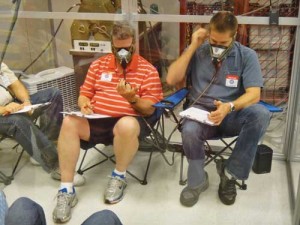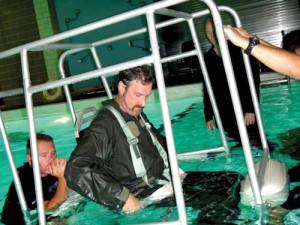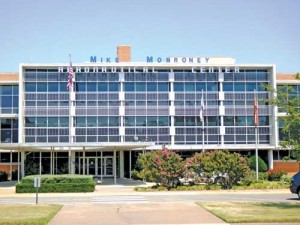by Pete Aarsvold
The FAA Civil Aerospace Medical Institute (CAMI) located at Will Rogers World Airport in Oklahoma City, Okla., offers a one-day training course to familiarize U.S. civil aviation pilots and flight crews with the physiological and psychological stress of flight. In addition to the basic academic course contents, the class offers practical hands-on demonstrations of rapid decompression (8,000 – 18,000 feet AGL) and hypoxia (25,000 feet AGL) using a hypobaric (altitude) chamber and a safe, practical demonstration of “pilot’s vertigo” using a Spatial Disorientation Demonstrator.
CAMI also offers a one-day post-crash survival course for general aviation pilots. It is designed to be an introduction, which provides basic knowledge and skills for coping with various common survival scenarios. In addition, the course teaches pilots how to easily assemble and use a personal survival kit.
There is no charge for registering and participating in these training classes. Transportation, food, and lodging expenses are the only costs that you are responsible for.
Fellow pilots Steve Pate, Ray Koenig and I embarked on what proved to be an excellent chance to learn about things to make us safer and more prepared pilots.
We arrived in Oklahoma City on a Sunday, two days earlier than needed, to avoid forecast thunderstorms along our route of flight. We were flying a 1978 Cessna 182 Skylane with retractable gear. We filed an IFR flight plan direct and flew at a comfortable altitude of 8,000 feet. Distance direct from Dane County Regional Airport, Madison, Wisconsin (KMSN) to Will Rogers Airport, Oklahoma City, Okla. (KOKC), was just over 600 nm. The non-stop time enroute was 4 hours and 30 minutes and we landed with more than 2 hours of fuel on reserve.
Winds and temperature can be adverse in Oklahoma, especially in the summer. Therefore, hangar storage during one’s stay is strongly recommended. At the very least, secure your aircraft using extra strength tie-downs. We opted to hangar at Atlantic Aviation and they took very good care of us.
Arriving early gave us an opportunity to visit the Oklahoma City National Memorial on Monday. The memorial is located at the site where Timothy McVeigh parked a Ryder rental truck filled with explosives in front of the Alfred P. Murrah Federal Building. The resulting explosion killed 168 people and destroyed the entire north face of the building. Visiting the memorial is a moving experience I highly recommend.
Tuesday morning, we arrived at the Mike Monroney Aeronautical Center visitor check-in area located at Will Rogers World Airport. The aeronautical center is huge and employs more than 5,000 government employees involved with training air traffic controllers, transportation security agents, department of homeland security employees, military personnel, and civilian flight personnel and others.

Contributing writer, Pete Aarsvold (left), recovers from the effects of hypoxia using an oxygen mask after lasting 5 minutes without one at a simulated altitude of 25,000 feet. Recovery after donning the oxygen mask is almost instantaneous.
The classroom presentation for Aerospace Physiology Training was very informative, but my favorite part of the day began just after lunch and involved hands-on exposure to “hypoxia.” We entered the hypoxia chamber in groups of four. The room had Plexiglas walls so our classmates could observe what happens when pilots and crewmembers experience hypoxia. We had ready access to oxygen masks and were encouraged to don the masks at any time during our 5-minute exposure to an oxygen-deprived environment simulating an altitude of 25,000 feet AGL. After each minute in the chamber, we were asked to note symptoms of hypoxia.
Possible hypoxia symptoms included tingling, rapid breathing, high pulse rate, fatigue, headache, dizziness, unusual feelings of hot/cold, tunnel vision, loss of color awareness, numbness, nausea, and other symptoms. Some participants donned their oxygen mask early and others later in the 5-minute experience. Most who lasted the entire 5 minutes didn’t remember the last 2 minutes in the chamber. Interestingly, the participants who lasted the longest without oxygen were able to complete simple tasks with a great deal of effort, but did not remember doing the tasks. One of the participants was asked to point his hands in the direction of a dive, yet aimed his hands skyward. When asked to indicate a climb, he directed his hands towards the ground. During an interview conducted after the participant donned his oxygen mask, he didn’t even remember being asked to complete this simple task of climbing and diving.
The symptoms of hypoxia stop almost instantly after donning the oxygen mask. Recovery is almost immediate. CAMI recommends the use of supplemental oxygen anytime when flying above 8,000 feet AGL. If flying at night, CAMI recommends the use of supplemental oxygen above 5,000 feet AGL.
After experiencing symptoms of hypoxia, it was time to experience “vertigo” using a Spatial Disorientation Demonstrator. We now know more than ever to not pick up a pencil from the floor of an airplane while in instrument flight conditions. You have to experience this yourself to fully respect the effects of vertigo. The impact of vertigo can be very serious. If you focus on the instrument panel and use appropriate scan technique, the symptoms of vertigo can be significantly reduced.
Aerospace Physiology & Emergency Preparedness
Aviation physiology courses taught at the Mike Monroney Aeronautical Center and participating military facilities provide essentially the same training. The following topics are covered during the training (listed in order of presentation):
• Physics of the Atmosphere
• Respiration and Circulation
• Decompressions
• Stress
• Hypoxia
• Hyperventilation
• Decompression Sickness
• Pressure Equalization Difficulties
• General Aviation Oxygen Equipment
• Altitude Chamber Oxygen Equipment Familiarization
• Altitude Chamber Flight Profile & Flight
• Spatial Disorientation, including demonstrators, if available:
– Gyro Spatial Disorientation Demonstrator
– Virtual Reality Spatial Disorientation Demonstrator
Post Crash Survival Training
Wednesday morning at 8:00 am, we started with a classroom presentation for Basic Survival Training. By lunchtime, we were ready for the practical hands-on portion of that training. We received a practical demonstration for fire starting without using matches. After the demo, we had a chance to try it for ourselves. Using a small amount of very fine steel wool, a cotton ball, and a 9-volt battery, we had all that we needed to get a fire started in less than 1 minute.
Next, we were attired in flight suits and asked to wear the life vests commonly found on commercial airliners. We entered the water survival lab, resembling an indoor swimming pool, and practiced inflating the life vests and swimming while wearing them. We learned that maintaining core body temperature is essential to water survival and practiced multiple techniques to maximize the preservation of core body temperature. A life raft was provided and we independently boarded it. Boarding a life raft is not easy to do at first, but it gets much easier after learning the proper technique.
We practiced entering a rescue pick-up basket and were hoisted skyward using an overhead crane. Apparently, the FAA helicopter rescue pilots are not allowed to fly indoors.

Ready for the great escape in a simulated aircraft cockpit, which was inverted and submerged in a swimming pool.
The next water survival lab experience involved underwater egress from a simulated aircraft cockpit inverted and submerged in the swimming pool. The FAA instructors taught us correct technique for opening the aircraft door, releasing the four-point seat belt, and swimming in the same direction as the bubbles to the surface in order to safely egress the simulated submerged aircraft. It is really an amazing experience! Though we sincerely hope to never be in this situation, we assure you that our chances for survival are much improved having learned the proper technique.
Course Content
Basic survival training consists of information on the following topics including classroom instruction and hands-on practical experience, listed in order of presentation:
• Psychology of Survival
• Overview of Search & Rescue Operations
• Personal Survival Kits
• Fire Starting with Lab
• Hot Land Survival
• Cold Land Survival
• Signaling with Lab (weather permitting)
• Aircraft (Smoke) Evacuation with Lab
• Ditching and Sea Survival
• Underwater Egress
• Water Survival Lab consisting of:
– Ditching and Egress
– Floatation and Swimming
– Raft Boarding and Righting
– Rescue (pick-up) Devices
– Shallow Water Egress Trainer (Voluntary)
The course concluded at 4:00 p.m. on Wednesday and we filed an IFR flight plan for 9,000 feet direct to KMSN. Our enroute time was 4 hours and 20 minutes. The weather was perfect without a cloud in sight during the entire flight. Our arrival at KMSN was just before 10:00 p.m.
It is surprising that CAMI classes for Aerospace Physiology and Post Crash Survival are offered for free. If you can get away for a couple of days, I strongly recommend that you register and participate in this excellent training opportunity. The FAA training staff and facilities are excellent. The techniques we learned have improved our aviation safety perspective and our readiness for the unexpected.
CAMI’s Airman Education Program personnel will provide available training dates for classes. Classes are scheduled starting on the first workday of each month for the month 90 days away (for example, scheduling for July classes would begin the first workday of May) and are filled on a first-call, first-filled basis. To obtain available class dates and/or enroll for class seats, call Monday through Friday from 7:30 am to 4:00 pm (CST) at (405) 954-4837. The following information is required to enroll in a class:
• Full Name
• Date of Birth
• Name of Organization (if applicable)
• Mailing Address
• Daytime Telephone Number
• Aircrew Position or Non-Aircrew Occupation
Please do not hesitate to contact me should you have any questions.
EDITOR’S NOTE: Peter Aarsvold is a flight instructor (CFI) at Morey Airplane Company in Middleton, Wisconsin (C29). When not instructing, Aarsvold is First Vice President & Commercial Loan Manager at Bankers’ Bank in Madison, Wisconsin.













Pingback: ราคาบอลวันนี้
Pingback: look at here now
Pingback: naza24
Pingback: niches youtube